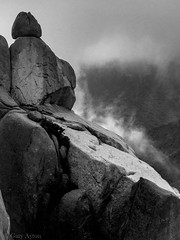I love infrared photography. In the middle of the day when the light is not conducive to good landscape shots, you can always resort to infrared photography.
The problem with modern digital cameras is that with each new generation, the infrared blocking filter has been becoming stronger making IR exposures with an infrared filter such as a Hoya R72, longer and longer such that exposures of 10-25 secs in bright sunlight are not uncommon.
Up until now, I tend to use my Canon 1D Mark III with Olympus OM wide angle lenses on a tripod. You have to take the filter off, compose, manually focus the lens, then adjust the focus to the red marker on the lens to account for infrared wavelengths, reapply the IR filter (now you can’t see anything in the viewfinder or in live view), then guess the exposure manually.
OK, so that was not so much fun, especially carrying around your tripod, setting it up then deciding you didn’t like it anyway.
BUT, now there is Micro Four Thirds to the rescue, the EVF on the Panasonic GH-1 displays the IR image beautifully so, not only can you compose with the Hoya R72 filter on a Leica-D 25mm f/1.4 lens, but it will accurately autofocus it quickly (except in darker shadow areas), and in bright sunlight, you can do a carefully hand held shot at ISO 800, f/1.4, 1/15sec, and, not only this but you can bump up the ISO to 1600 and use 1/30th sec for HD video hand held – now that is cool!!
Of course, if you have your tripod, or you use an Olympus Micro Four Thirds with in-built image stabiliser, you can get away with lower ISO for still shots.
Here are a few quick ones I shot today with the GH-1 with Leica-D 25mm f/1.4 (with a 58mm Hoya R72 filter via a 62-58mm step down) – not the most exciting, but shows what is possible even on cloudy days (it was cold, windy and very cloudy today, so sorry I don’t have much full sunlight shots to show):
First, an optimistic hand held shot in cloudy lighting at ISO 800, 1/10th sec – a bit of camera blur, but you get the idea, and it shows a nice Wood’s effect (B&W film mode jpeg):
Next, another cloudy day shot, this time the camera was partly supported on a wire fence at ISO 1600, f/1.4, 1/10th sec (Custom WB jpeg converted to monochrome in PS):
Lastly, the sun came out briefly for a part sun shot, camera rested on a fence post, ISO 100, f/1.4, 1sec exposure (Custom WB jpeg converted to monochrome in PS):
More information on infrared photography here.
More of my digital infrared photos here.
Now, if Olympus can bring out an image stabilised MFT camera with a nice EVF, then hand held infrared photography will be even easier.
I have just checked and the exposure for IR is practically the same on the Olympus E510 as on the Panasonic GH-1, so what I am really seeing is the benefit of the superb f/1.4 aperture of the Leica-D 25mm lens. The advantage of the E510 is that it is image stabilised but the advantage of the GH-1 is not only its video capability but the EVF allows full time composition and ability to quickly AF rather than rely on the cumbersome MF assist live view of the E510.














Hi, that sounds interesting. Could you explain how to use infrared with a Gh1, do I need to have hot mirror filter removed? Please reply via mail if you can.
Thanks a lot.
email sent Dennis – you don’t need the IR blocking filter removed if you use a wide aperture lens.
Thx for the insight.
I’m most interested in shooting IR video with the GH1. You mentioned you can shoot video with 1/30sec shutter at ISO1600. That seems to be pushing the limit. What about under less-than-sunny condition?
If it shoots video well, I don’t even mind sending a GH1 for a permanent IR filter removal. I wonder how the camera would behave after the conversion (in terms of AF, video, exposure for indoor/night, etc)? Can I produce color IR video (with some channel mixing in post to take out the red)?
GH-1 will shoot IR video unmodified in bright sunlight, albeit requiring a lens with aperture f/1.4 such as the Leica-D 25mm f/1.4 Four Thirds lens with an R72 filter.
You can set the film mode to B&W dynamic and this will be used during video mode. I presume you could shoot in normal colour mode then use a video software to post-process the video to get some false colour effects – I have not tried this but I suspect it would be possible.
The GH-1 will allow even slower shutter speeds in full manual video mode, and this may be used to create some very creative IR videos and allow use in less bright situations. Maximum ISO in video mode though seems to be 1600.
As the GH-1 focuses using the sensor image and not a separate AF system as with dSLRs, there should not be a problem with AF if you have the IR filter removed although I have not heard of anyone doing this as yet.
Gary
Olympus Now already brought out an image stabilised MFT camera with a nice EVF.
It’s the E-P2.